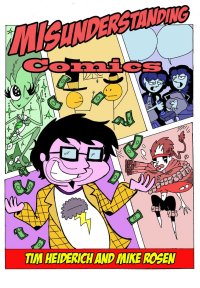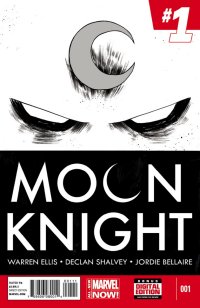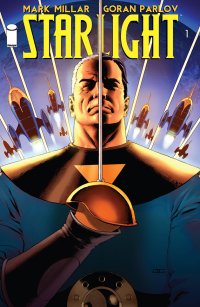Infinity [Hardcover] (Marvel, $75.00)
by Graig Kent
Back in 2006 Marvel launched their summer event Civil War, a crossover that would see heroes facing off against heroes on ideological issues, culminating in the apparent death of Captain America and Norman Osborne presidential election. It was to redefine the Marvel landscape and be the trigger point for another 5 years of epics and events, largely centered around the Avengers titles under Brian Michael Bendis’ architectural guidance. It was a bizarrely tight knit universe for a while (or at least subsection thereof), joined in a consistency in tone, a heaviness, a weariness grinding through the tail end of the Bush years and reacting to the fallout thereof in its own peculiar way.
Late 2012 saw the publisher start its relaunch initiative, Marvel Now, and point towards a bit of a brighter, more diverse Marvel Universe, expressing a bit more optimism and shaking off the yoke of bitter politics and in-fighting. Bendis passed the Avengers torch over to Jonathan Hickman, who had just come out of an epic run on Fantastic Four (which also saw the creation of the Future Foundation). Hickman took on both the twice-monthly Avengers and monthly New Avengers titles (effectively writing three Avengers books a month) and from page one, in hindsight it’s readily apparent Hickman had big, big plans.
To say those plans culminated in the mega-crossover Infinity would be to assume that his plans concluded at the end of the event. If there’s one disappointment to reading the roughly 630 page hardcover, it’s that it isn’t an entirely self-contained story. There is an epic story in these pages, but it doesn’t start here and it doesn’t end here.
The Infinity mini-series was six issues, the bookends being triple-sized each, the middle four issues double-sized (all told equivalent to 14 issues) and, reading this hardcover, I can’t imagine how friendly it might have been to the new reader just picking it off the shelf. 12 issues of Avengers and 6 issues of New Avengers led into the mini-series, each having their own piece of the Infinity puzzle to dispense, and, at least in the way this hardcover was edited together, the two titles carried on completely interwoven into the crossover (so in addition to the 6-issue mini-series, this hardcover collect 12 Avengers and 6 New Avengers issues). Stepping in without having read either Avengers series would likely prove frustrating. I had brushed up on the Avengers and New Avengers (3 trades worth) before heading into this mammoth collection, and I still found the opening few chapters (one issue of New Avengers and two or three issues of Avengers) to be rather complex and deliberately paced. The story and character arcs of each series continue almost unabated (which would set readers starting with this volume behind somewhat) until Infinity begins, at which point there’s three major storylines all contending for page space. It becomes a dizzying whirlwind of countless characters, settings, backstory and action.
But what a whirlwind it is.
In the main Avengers comic, we were previously introduced to the concept of the Builders, the architects of the Universe. Thrust number one of Infinity is the Builders are on a trajectory towards Earth, eliminating all traces of civilization along the way. The Avengers, led by Captain America, head out into space to form a coalition of the greatest alien races (the Shi’ar, the Kree, the Skrulls, the Brood, etc) to face this seemingly invincible opponent head on. Meanwhile, in New Avengers, the Illuminati (the self-appointed overseers of Earth’s evolution: Iron Man, Mr. Fantastic, Dr. Fate, Namor, Black Panther, Black Bolt and Beast) have uncovered a greater threat. Parallel Earths are starting to collide with one another. If one Earth isn’t eliminated, both will be destroyed. Dealing with this threat (and the burden of potentially eliminating parallel civilizations to save their own), and with the bulk of the Avengers off-planet, it isn’t the best time for Thanos to make his own run at destroying the planet, for his own, very personal reasons. Beyond these shades of grey are even more gradients, chief among them the warring nations of Wakanda and Atlantis (the dynamic between Namor and T’Challa is intense, to say the least), and a bold plan underway in the Inhuman city of Attilan…this all stemming from the brainpan of Jonathan Hickman.
I’ve been a fan and avid follower of Hickman’s since the first issue of The Nightly News over a half decade ago, and even if I don’t like a story I’m rarely left unimpressed with what the writer was attempting with any given book or series. I can’t claim Infinity is an outright triumph that everyone will flat out love, but it’s certainly an epic event done the Jonathan Hickman way, like none that have come before. It is truly an unequivocal success in that regard, with Hickman’s telltale title cards creating chapter breaks every few pages (sometimes one, sometimes ten), breaking the many story threads into nugget-sized bites. It’s a very unique read, and the constant jumping about is challenging at first, but eventually creates a relentless pacing that utterly sucks you in. As a whole, the story takes hold, and even though it’s difficult to see how the disparate pieces fit together, that’s part of the pull of it.
As he proved with his Fantastic Four/FF run (and to a lesser degree with his year on The Ultimates and even his ongoing Image series Manhattan Projects and East of West) Hickman is a master of the long-game. He knows how to seed and build on top of those seeds like nobody else in comics today. There’s roughly 1000 pages of material leading into and including this collection, all produced (or at least published) in the span of one year, and the story isn’t done yet. As grand architect he was given the reins and he went with it full speed, and it’s impressive, if not for everyone.
Some might have a problem with dropping $75 for a story that is incomplete, while others may find issue with the structure of the story, too dense, or too challenging. Fair enough. But I fully appreciate the achievement, and am impressed with the execution. Though not as accessible, this is still Hickman at the top of his game, delivering some incredible, complex storytelling with epic moments that doesn’t just end where it began but reshapes the Marvel Universe in big, bold strokes. Like Civil War did so many years ago (it’s not really that long ago is it?), Infinity is the starting point for a new Marvel universe. The cosmos has changed, the multiverse is shifting, and Earth is undergoing its own evolution.
Not for nothing, obviously Hickman didn’t do this all alone. There’s a massive team of artists (Jim Cheung, Jerome Opena, Dustin Weaver, Leinil Francis Yu, Stefano Casselli and more) as well as Nick Spencer lending an assist on the Avengers scripts and a team of editors (both in the original printing and in this collection), who made everything look and read so exceptionally well. A special call out to collection editor Jennifer Grunwald, who must have had a bit of a challenge in making this epic tome comprised of three different series flow together as one, but she did it. It’s a steal at $75 (at least compared to the total price of purchasing all the individual books it collects), or less (depending on your retailer/online source), but to really get the fullest story experience, expect to shell out for the preceding and subsequent Avengers and New Avengers collections.
Rating: 




Out of a Possible 5 Stars
Note: I’ve seen a bit of commentary about the poor paper quality of the Infinity trade. Honestly, unless you’re a real paper nerd, you’re not going to really notice anything amiss.
 Misunderstanding Comics graphic novel (Heidenrich & Rosen, $15 trade format, $9.99 digital format)
Misunderstanding Comics graphic novel (Heidenrich & Rosen, $15 trade format, $9.99 digital format)
By Cat Taylor
Several years ago, a comic was published called Understanding Comics. This book used the comic book sequential art form to explain just about everything there is to know about comics as if someone had never seen one before. The book was narrated by a character who was drawn to look like a tween heartthrob playing a nerd with a heart of gold in a movie for the Twilight audience. And that’s about all I know about it because I never read it. However, I did just read the parody of that book called Misunderstanding Comics written by Tim Heiderich and drawn by Mike Rosen. From what I can tell, this book follows the same format down to having its own “nerd” narrator. However, the explanations in the different chapters of this book that are dedicated to such comic book staples such as characters, plots, art, history, and types of comics, are used to skewer all the clichés and thin routines that occur everywhere in the medium. Perhaps you think that because you’re reading independent or underground comics, you’re avoiding the clichés of Batman and the X-Men. Well, you may be avoiding THOSE clichés but the underground comics have clichés of their own, as this book points out in equal and amusing measure. The other thing I want to add about this book is that there is a LOT of content here. In fact, it’s too bad winter’s almost over because this would be a good book to take in on those long snow days.
Anytime you have a work of parody, individual styles are buried beneath what the creators are spoofing. So, without knowing more about Mike Rosen’s artwork, all I can say is that he’s talented enough to be able to imitate a wide variety of styles to a level effective enough that you know what he’s trying to say. In the case of a book like this, that more than gets the job done.
As anyone who has ever enjoyed a good parody knows, the best parodies are done by people who have the greatest love for the thing they are parodying. Parodies by non-fans miss the mark because non-fans don’t have deep enough knowledge of the material to make effective satire. By that standard, it appears that Heidenrich and Rosen are life-long comic fans. However, even though the critiques appear to be mostly tongue-in-cheek, they are so thorough and all-encompassing that it made me wonder how someone can find so much wrong with a medium and still be a fan. It could be that Heidenrich has just finally gotten burned out on the predictable routines of the medium and this is his last word on everything comic book before giving up on them altogether. With all the cynicism displayed in this book, you’d almost think Heidenrich was a comic book reviewer on a niche website or something.
Rating: 3.0
MOON KNIGHT #1 (Marvel Comics, $3.99)
By Devon Sanders (@devonsanders)
I’ve been sick this whole week. Last night, I felt a little better and drank a beer while reading writer Warren Ellis and artist Declan Shalvey’s new Moon Knight #1.
The effects of not having had any alcohol in weeks, my hacking up phlegmy bits for days and anything to do with Warren Ellis writing a comic about a mercenary turned Avenger with dissociative identity disorder who also believes he is the fist of a dead Egyptian goes a long way towards believing the world was ready for me to read this comic. I mean this in the best way possible.
When last I saw Moon Knight, Warren Ellis had Steve Rogers aka Captain America dispatch Moon Knight to take out a Russian drug ring who were peddling a drug that when snorted, would release the souls of the dead into your bloodstream.
I remember thinking I’d like to see more of this.
After a brief hiatus from comics, Warren Ellis’ Moon Knight is a thing and I am glad to have read the thing.
Ellis, in one page, addresses the more confusing and convoluted aspects of Moon Knight and gets on with telling the story he wants to tell; a tale of serial murder.
Bodybuilders, bouncers and the generally fit, lie dead in alleyways with major muscle groups surgically removed from their bodies. Moon Knight is invited in to consult by The NYPD and quickly unravels a forgotten link to the highest levels of government.
Ellis is the rare writer who can address the inherent ridiculousness of superheroics and spin it into something resembling real world context. In Ellis’ Moon Knight, we see a man struggling with his many aspects and managing to find an outlet within himself. Yes, it’s very Batman-ish but in Ellis’ hands, it becomes something different. Not so much a mission but a prayer, almost for help or redemption. I’m not sure where he’s taking this but I’m definitely more than intrigued.
Declan Shalvey’s art perfectly suits this book, falling somewhere into the photorealism of artist Michael Lark and the noir sensibilities of Gabriel Hardman. Shalvey brilliantly captures chaos; whether it be the underbelly of New York City or the mind of Moon Knight’s alter ego, Marc Spector, he just makes it all work beautifully for the comics page.
Moon Knight #1 is a weird and wonderful comic; it mines the past while setting its eye on the future; in short, one of many great, recent Marvel re-launches.
Rating: 




Out of a Possible 5 Stars
 Starlight #1 (Image, $2.99)
Starlight #1 (Image, $2.99)
By Jeb D.
I suppose that if any author would find it appropriate to write their own reviews, it would be Mark Millar; that, in effect, is what he does on the back cover of this comic:
“Forty years ago, Duke McQueen was the space hero who saved the universe. But then he came back home, got married, had kids, and grew old. Now his children have left, and his wife has passed away, leaving him alone with nothing except his memories… until a call comes from a distant world asking him back for his greatest adventure.”
I mean, that pretty much sums things up: after you’ve read it, you have every story beat in this first issue down, and any real evalutation of the series will have to wait till we see what Millar does with the premise.
Though Millar’s advance marketing comparisons to Flash Gordon were hastily played down/retracted when King Features’ lawyers got involved, the particulars of this comic actually owe as much to the films of Pixar as any other source: the recap of Duke’s blissful life with his late wife Joanne has much of the bittersweet nostalgia of the opening sequence of Up; and not only does Millar have Duke contemplating his formerly adventurous life a la The Incredibles, we’re also treated to a fairly blatant lift of the scene of Mr Incredible, alone in his den, pensively reliving past glories and newspaper clippings. Not that it’s anything unusual for Millar to riff on (rip off?) familiar properties, but given how specifically familiar these cultural touchstones are, it just reinforces the fact that Millar doesn’t really bring much more to this first issue than a simple precis of the concept; readers who might choose to start with issue #2 won’t have missed much.
Well, actually, they’ll miss some suprisingly nice artwork from Goran Parlov-and I don’t mean “surprising” in the sense of his not being an accomplished artist, but in the sense that this is definitely not the kind of story you’d naturally hand to a guy who’s made his bones on the MAX versions of The Punisher and Nick Fury. His depiction of Duke’s mundane suburban life has a flat quality that underlines the meaningless of Duke’s newly solitary existence, while the flashbacks to Duke’s adventures on the planet Tantalus are less reminiscent of the detailed artwork of someone like Alex Raymond or Hal Foster, than of the roughly elegant 70’s work of P. Craig Russell, or some of the more whimsical Heavy Metal artists. Thanks to the stellar work of colorist Ive Svorcina, Parlov doesn’t have to make jarring contrasts between Duke’s two realms: Tantalus is given a bright color palette derived from classic Sunday newspaper comics, while Earth is drab and ordinary. It’s more than capable artwork in general, though I have to admit that it works better if you ignore Millar’s ludicrous hyperbole (“the artwork is possibly the best I’ve ever seen in a comic“).
Given Millar’s evident desire to see everything he’s ever written become a movie (I’ve often wondered if he lost interest in War Heroes because he couldn’t gin up much interest from Hollywood), this first issue reads more like an elevator pitch than anything else: from the synopsis quoted above, it’s almost too easy to imagine the inevitable movie adaptation. For what it’s worth, this is also supposed to kick off an integrated comic “Millarverse” (which may or may not include titles like Superior and Jupiter’s Legacy), if that’s of interest. Otherwise, it’s slightly lower-key Millar than usual (few pop culture references, nothing included for cheap shock value– yet), and sets up the story well enough. But it’ll cost you an additional three bucks next month to see if it’s actually going to be worth reading.
Rating: 




Out of a Possible 5 Stars
Evil Empire #1 (Boom!, $3.99)
By Cat Taylor
The plot synopsis for Evil Empire talks about how in most science fiction and comic book stories, an evil empire is in control and the heroic rebels are seeking to overthrow it but there’s usually the unanswered question of how the evil overlords took control in the first place. Evil Empire claims to be the story to answer that question by showing the circumstances that would make the general public allow, and even want, to give control to a tyrant. While I’m somewhat intrigued to see how this particular comic tells the story, I don’t find this type of story to be original, fascinating, or even an unanswered question. We don’t have to look any further than modern history to see several true stories of how such things have really happened. Most obviously, Adolf Hitler’s rise to power is the textbook example. If that’s too real for you, one of the few things that the Star Wars prequels did well was offer a fairly satisfactory answer of the origin of the Galactic Empire.
So far the most impressive thing about this comic is the art. Ransom Getty has a solid style that ranks up there with the best that Marvel and DC have to offer. On the writing side, there is a good narrative flow that pulls the reader through the story with clarity. However, the characterizations and plot points feel too inauthentic. For instance, the opening segment shows four thugs with a baseball bat and one other handled weapon that isn’t clearly shown, get chased off by one man with a pocket knife. Unless that one man is Batman, I just couldn’t buy that the four of them wouldn’t turn around and beat the crap out of him. Also, Reese, the heroine of the story is an anti-authoritarian rock star, but she’s far too easily swayed by the “cool” presidential candidate who comes off equally inauthentic, and more stalkery than cool. The inauthentic nature of the candidate, Sam Duggins, could be intentional since he is a politician, but I have a hard time believing that the public in general, and especially the story’s heroine, wouldn’t see right through him. Furthermore, the rock star of the story seems so unreal that I wouldn’t be surprised to find out that the writer, Max Bemis, knows as little about rock-n-roll as I do about football. Case in point, several panels show her singing one of her songs and the lyrics are ridiculous. Not only do they read like something nobody with any songwriting experience would ever write, but they have no rhythmic flow.
Even though I question the uniqueness of the premise of this comic, there is still room for the writer, Max Bemis, to tell an interesting story. However, the first issue feels like it’s going down a predictable road. Granted, I could be wrong, but at this point I don’t see a way to tell a believable story without taking the obvious route of making the “cool” politician become the future evil dictator. With that being said, I will add that the even though the final panels depict another scenario I had trouble buying into, it was a shocking cliffhanger. Perhaps the characters will start to become more complex and believable in future issues, perhaps I could be completely wrong with where all of this is going, and perhaps Bemis will find a satisfactory and believable way to steer the storylines in directions that don’t seem obvious.
Rating: 




Out of a Possible 5 Stars